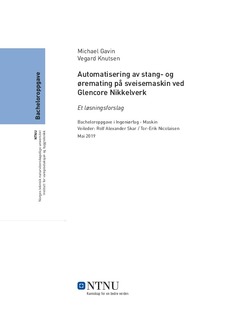| dc.contributor.advisor | Skar, Rolf Alexander | |
| dc.contributor.advisor | Nicolaisen, Tor-Erik | |
| dc.contributor.author | Gavin, Michael | |
| dc.contributor.author | Knutsen, Vegard | |
| dc.date.accessioned | 2019-09-06T14:02:13Z | |
| dc.date.available | 2019-09-06T14:02:13Z | |
| dc.date.issued | 2019 | |
| dc.identifier.uri | http://hdl.handle.net/11250/2613150 | |
| dc.description.abstract | Prosjektet er gjennomført på oppdrag fra Glencore Nikkelverk i Kristiansand. Nikkelverk har i dag en Sveisemaskin som setter sammen en tynn nikkel plate, en stang og to nikkel «ører» til en katode til bruk i en elektrolytisk prosess. Mating av stenger og ører inn i sveisemaskinen er i dag en manuell prosess utført av en operatør. 17576 stenger og 35152 ører er ukentlig matet for hånd inn i maskinen. Gruppen fikk i oppdrag å lage et forslag til hvordan denne håndmatingsprosess kan automatiseres. Utfordringer med dagens prosess har blitt kartlagt, mulige løsninger drøftet og testet, og et forslag til løsning modellert og analysert. | |
| dc.description.abstract | Objective:
This report examines the manual feeding of rods and ears into a machine for the production of starting cathodes, with the purpose of producing a proposed solution for the automation of these tasks.
Method:
A combination of quantitative and qualitative methods has been used to examine the two tasks.
Ear feeding: The main problem in this task is double handling, requiring an operator to transfer ears from a transport crate into a feeding crate.
Rod feeding: The greatest challenge with this operation is how to grab hold of a rod stacked in a transport crate. We tested various ideas, and concluded that it would be necessary to separate each rod from the stack. Methods of grabbing each rod while still in the transport crate (mechanical, magnetic, vacuum) were discarded as impractical or impossible.
Conclusion:
In a logistics context, these are both “pick-and-place” tasks that are suitable for automation.
Our recommendation is that the manual feeding station be rebuilt as shown in Chapter 4 allowing automatic feeding of rods and ears from their transport crates.
In this report, we have proposed a mechanical solution only. A substantial amount of engineering work concerning automation and signals, programming and electrical would need to be carried out if this solution were to be implemented. | |
| dc.language | nob | |
| dc.publisher | NTNU | |
| dc.title | Automatisering av stang- og øremating på sveisemaskin ved Glencore Nikkelverk | |
| dc.type | Bachelor thesis | |
